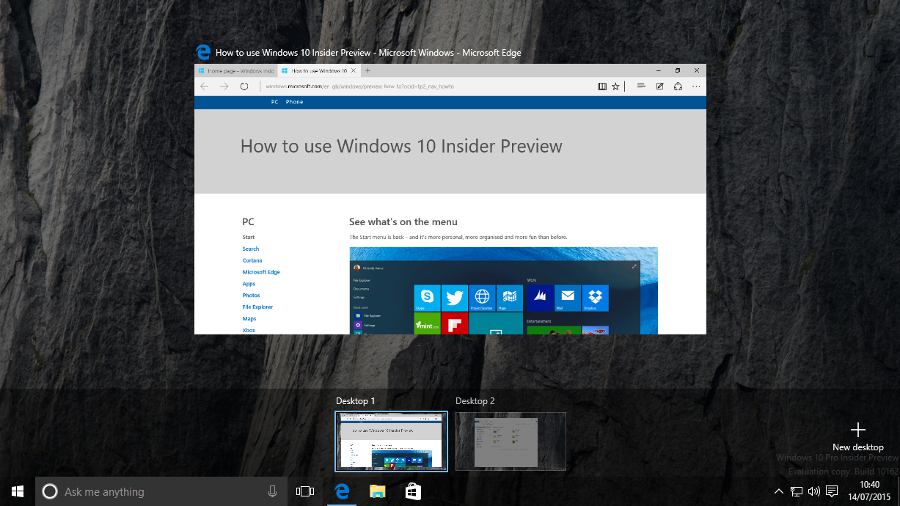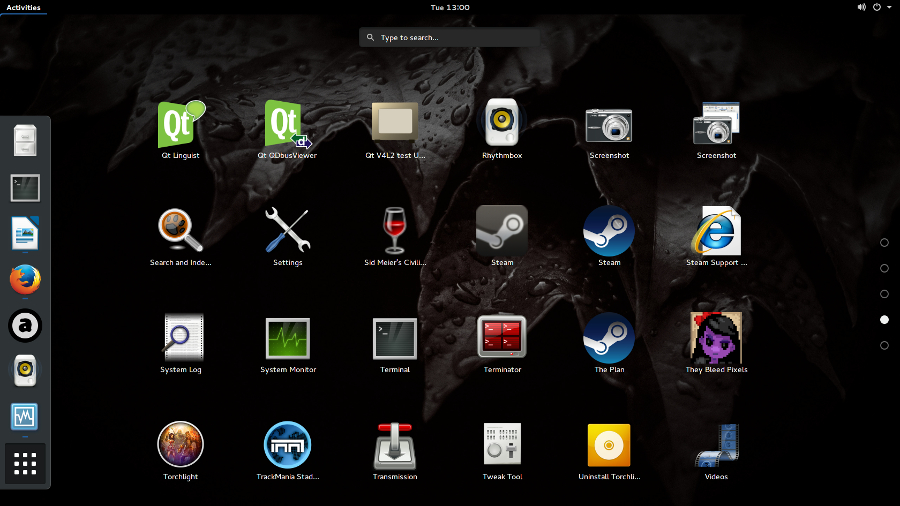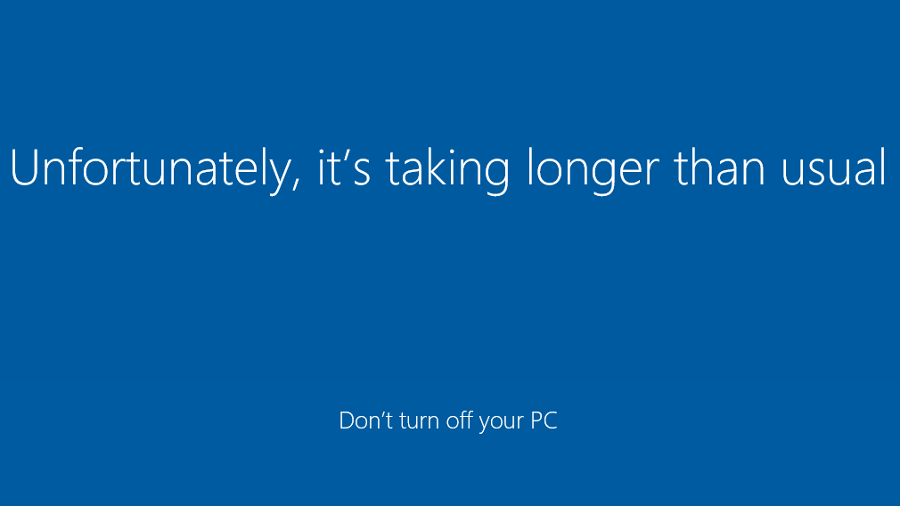OS showdown: Windows 10 vs Linux
"Borrowed" features
As people do more and more on their desktops – what with multiple browser windows, Skype conversations, music players and whatever is the latest thing the kids nowadays are up to – desktop real estate becomes a scarce resource. Thanks to high resolution, widescreen displays the situation is not as bad as it used to be, but imagine if you could have group different applications or windows together on a single "virtual desktop".
The latest Windows offering lets you do exactly this, with its new Task View feature. Testing via Windows Insider program found that users preferred to have only icons from the current desktop visible, so this is the default setting. Previews of all available desktops can be accessed with a click/tap of the Task View button or using the Windows-Tab key combination. At the moment this is a little clumsy though, since invoking the keyboard shortcut places the focus inside the current desktop preview. A couple of extra key presses are required to actually cycle through other desktops and the applications running therein.

Virtual desktops have been available on Windows through third party programs since the XP days, but more often than not these just used ugly hacks to hide and group various entries on the taskbar. This confuses a number of applications, which are hardwired to believe there can be only one (desktop, not Highlander). The discerning reader will of course be aware that virtual desktops have been on Linux since the initial KDE and GNOME releases in the late 90s, and that they were around, in various guises, long before that in the days of the Amiga 1000 (1985) and the Solbourne window manager (1990). It's nice to see Microsoft join the party. Better late than never guys.
Task View in itself is also rather similar to Gnome Shell's Activities Overlay (the screen that shows all running applications). Like Gnome Shell, Windows 10 also features a central notification area (dubbed "Action Center"), so that one's tray is spared domination by dancing icons and toaster popups all vying for one's attention.
Typing Being able to livesearch applications (and in so doing get unwanted web results) from the Start bar is a nice feature, although it's been in Unity and Gnome Shell since their inception. The Unity Dash will even categorise various web results into 'lenses', but obviously it loses points because of the infamous Amazon sponsored results. Being able to see all installed applications is a useful feature. It was vaguely present in Windows 8 (and was in fact the only way to find newly installed applications), but again has been present in a much more useable form in modern Linux desktops for about five years.

Windows Powershell has been around since 2006, and the series sees a fifth instalment with the latest OS. One of its most touted features is that it provides something akin to a package manager. This amazing technology lets you source software from a trusted repository and install it without having to run the gauntlet of ambiguously worded questions relating to the installation of toolbars, smileys, or other bloatware. Packages can then be cleanly removed with a simple command.
The blurb from Redmond calls this Software Discovery, Installation and Inventory (SDII). If only we had something like this on Linux. Oh wait. At present, OneGet (being the title of this new tool) is just a collection of Powershell cmdlets that talks to the repository used by the third-party utility Chocolatey Nuget. This provides just shy of 3000 packages just now, an order of magnitude smaller than any Linux package manager. In future there will be many other repositories available, perhaps even an official Microsoft one. But at least you'll no longer need to fire up IE just to download your favourite browser, it can all be done by opening a Powershell window as administrator and typing:
Sign up for breaking news, reviews, opinion, top tech deals, and more.
Install-Package -Name Firefox -Provider chocolatey
Replace Firefox with GoogleChrome if you're that way inclined The -Provider argument proved to be necessary for disambiguation with another package called xFirefox when we tested, but hopefully things will have been tidied up now the OS has been launched. Naturally, Microsoft will encourage people to use the App Store as their first port of call for new software, but Powershell gurus will enjoy this method. Even if it's not a patch on Apt or DNF.
Windows as a Service can in some ways be compared to a rolling-release operating system, such as Arch or Linux Mint Debian Edition. At the same time the multi-branch release model for businesses is vaguely similar to Debian's release model. Indeed the whole Insider Preview model is a big old beta test itself, just like what has been happening with Steam OS over the past year-and-a-bit. But none of these are really Linux ideas, and it's actually pretty refreshing to see Microsoft co-opting them. Also pleasant is the fact that Microsoft's new OS is being offered as a free upgrade for those already running a legitimate copy of Windows 7 or later, but this move is largely a deal-sweetener for potential upgraders sitting on the fence.

Windows SSH
Another development which isn't strictly part of Windows 10 but which we'll happily include here nonetheless is that PowerShell is soon to be blessed with SSH functionality. So you will be able to connect to your Windows box and use awkward PowerShell syntax to administer it. While it has always been possible to run a third party SSH client, such as the venerable PuTTY, running a server involved installing the Cygwin environment which is pretty heavy duty. Interestingly, various bods at Microsoft have pressed for SSH inclusion, but traditionally they have been struck down by management.
Nadella, though, is much more tolerant of what his predecessor might have called 'commie' technology. In fact, team Redmond are actually going to contribute to the OpenSSH community. In fact, they've just become an OpenBSD (custodians of the OpenSSH project) "Gold" contributor by flinging a five-figure sum their way.
Likely there will be some that look upon this move with scepticism and others all too willing to quote the oft' jested Microsoft strategy: Embrace, Extend, Extinguish. But remember that didn't work with (MS)HTML and it won't work with SSH either. Who knows, maybe we'll even be able to blame Redmond for the next Heartbleed.
Current page: Borrowed bits and Windows SSH
Prev Page Introduction and market share Next Page Hardware and drivers